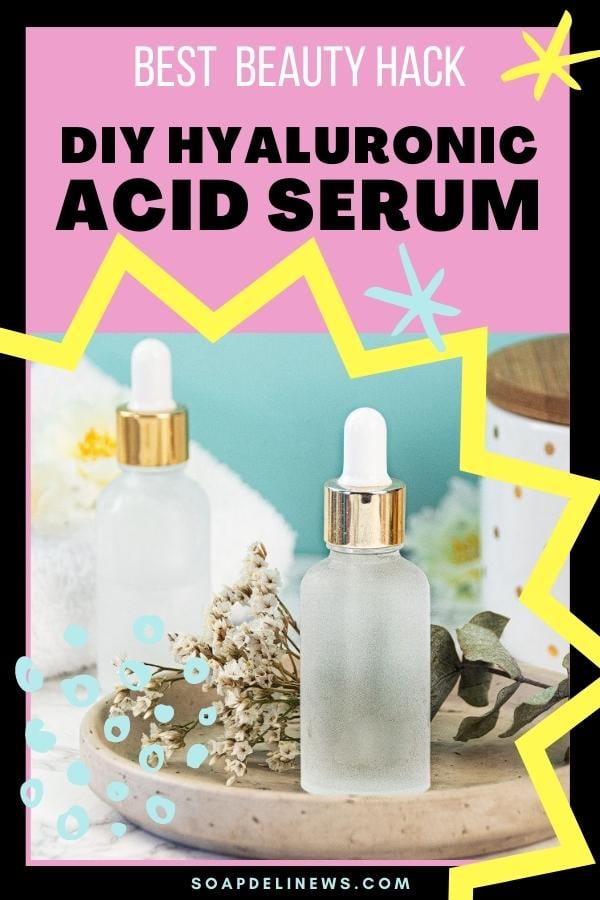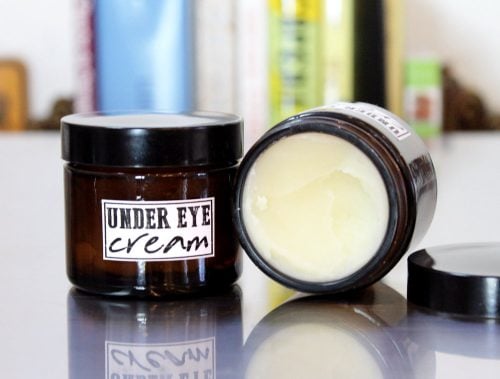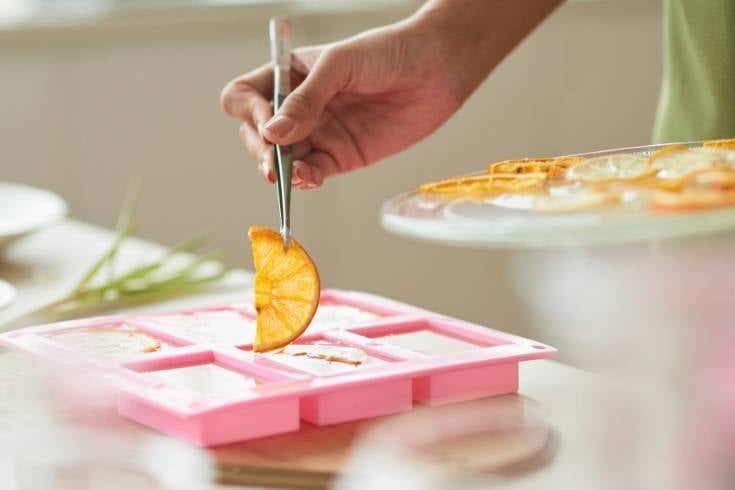
DIY Hyaluronic Acid Serum: Beauty Hack for Anti-Aging Skin Care
Naturally combat aging with this DIY hyaluronic acid serum. Learn how to make an anti-aging serum recipe for plump, youthful looking skin with as few as two ingredients. An affordable way to upgrade your beauty regimen on a budget, this hydrating beauty serum helps lock in moisture and plump skin to diminish the appearance of fine lines and wrinkles. You’re going to love the visible results of this easy DIY beauty hack!

Anti-Aging DIY Hyaluronic Acid Serum
An affordable alternative to store bought anti-aging serums, this DIY hyaluronic acid serum creates an amazing anti-aging gel that hydrates skin, helps to fight aging and reduce skin inflammation. It can also aid in increasing skin elasticity.
With as few as two ingredients — water and hyaluronic acid powder — you can help your skin to appear more youthful! Hyaluronic acid naturally moisturizes and plumps skin to diminish the appearance of wrinkles and fine lines. By making your own homemade beauty serum, you can also save a LOT of money versus buying serums. My 2-ingredient DIY hyaluronic acid serum is made using Bos Essentials Hyaluronic Acid Powder. This easy beauty solution offers an economical way for you to create your own anti-aging beauty products. Plus it really is so easy to make!
By formulating your own DIY anti-aging serum at home, you’ll enjoy the same benefits from store bought products without the high price tag. Discover how to make your own anti-aging DIY hyaluronic acid serum. Plus, I share a bonus recipe for a DIY Vitamin C serum. Keep reading to learn how to make these simple, affordable beauty hacks for your skin. Both recipes can be found below.
What Is Hyaluronic Acid?
Hyaluronic acid is also called hyaluronan or a hyaluronate. It is an anionic, nonsulfated glycosaminoglycan that is present in connective tissue in the body and found in eyes, skin and joints. Historically described as a goo molecule prior to the 1970s, this slippery substance is naturally produced by the body coating the cells of articular cartilage. In addition, it also lubricates the muscular connective tissues. As a major component of skin, hyaluronan is involved in the repair of skin tissue.
Hyaluronic acid is often taken as supplement to restore its loss. As both UV exposure and age can reduce the production of hyaluronan in the body. This compound may be taken orally or applied topically to skin. It is also sometimes injected or inhaled depending on what condition is being treated.
Medically, it may be used to treat osteoarthritis of the knees and in products that treat dry eye for the purpose of creating artificial tears. It is sometimes inhaled to treat asthma or breathing issues. However, it is most commonly used for skin care applications. While it is an ingredient found in fillers that are injected into skin, it’s also used as an ingredient in a number of topically applied beauty products to plump skin and restore hydration.
Hyaluronic Serum Benefits
Hyaluronic acid is commonly used as an ingredient in a number of skin care applications to address aging or dry skin as well as for medical applications. Here are the benefits of using a hyaluronic serum:
- As it plays a key role in tissue regeneration, inflammation response, and angiogenesis, hyaluronic acid may help promote healing of chronic wounds, burns and ulcers. While its effects may be limited and more research is needed, they do illustrate that hyaluronic acid is effective at reducing pain cause by ulcers.
- Because hyaluronic acid plays such an important role when it comes to our epidermis, or the outer layer of skin, it assists with healing skin.
- Its antioxidant properties help protect skin from outside elements such as solar radiation. When combined with retinoids, a form of vitamin A, it also increases hydration of skin tissue.
- Serums made with hyaluronic acid hydrates skin so it looks plump and more youthful. By keeping skin hydrated, you’re less likely to experience dry skin. It can also minimize the appearance of wrinkles.
- Its low molecular weight mean it’s easily absorbed by skin. This allows it to lock in moisture and slow down the visible signs of aging.
- It can be combined with other ingredients in DIY beauty serums to also tackle other skin care concerns, such as reducing inflammation or exfoliating skin.
- DIY beauty serums formulated with hyaluronic acid, such as my green tea serum, help improve skin elasticity.
What Does Hyaluronic Acid Do to Your Face?
As hyaluronic acid helps skin cells attract and retain moisture, it helps skin look and feel hydrated when it’s applied to your face. When skin is properly hydrated, it will make your face look plump and pillowy. This in turn helps to diminish the appearance of fine lines and wrinkles. It may also help to shield skin from free radicals and pollutants that age skin. So, skin looks radiant. After all, don’t we all want beautiful, glowing skin?
Hyaluronic Acid Serum Side Effects
Hyaluronic acid serum works for all skin types, even if you have sensitive or acne prone skin. Therefore, you don’t have to worry about this DIY beauty product causing breakouts. It also won’t strip skin of necessary oils like other products, so it’s safe to use on a daily basis. This serum is well tolerated when applied topically. Therefore, it doesn’t have any negative side effects to skin when used in a DIY beauty serum. However, additional ingredients found in some hyaluronic serums, such as retinol or vitamin C, may contribute to skin irritation or redness.
Very rarely does hyaluronic acid cause side effects. When it does, it’s typically an allergic reaction. As our bodies naturally produce this substance, allergic reactions typically only occur if it’s injected into the body as in the case of fillers or osteoarthritis.

Hyaluronic Acid Serum Recipe
This recipe for a hyaluronic serum can be created with as few as two-ingredients. However, additional ingredients can be used to customize your DIY beauty serum as well as to preserve the product.
Ingredients:
These are the ingredients you’ll need to make this homemade facial serum for skin:
- 2 teaspoons Bos Essentials Hyaluronic Acid Powder
- 7 fl. oz. distilled water
- 1 teaspoon vegetable glycerin, optional
How to Make Hyaluronic Acid Serum
Here is how to make a DIY anti-aging serum with hyaluronic acid:

1. Combine all of the ingredients in an airtight container and shake really well until it is thoroughly mixed. (I used a 9 oz. clear straight sided glass jars with silver metal lug caps that I had from SKS Bottle & Packaging which work great. But you can also use a small mason jar or dropper bottles. In short, choose the best container size for your needs and how you plan to use it. The larger container works great for all-over skin care and not just your face.)
2. Place the DIY hyaluronic acid serum in the refrigerator until it gels and is no longer grainy. Once the product has fully gelled, it’s ready to be used as part of your daily skin care routine.
Packaging
I used a 9 oz. clear straight sided glass jars with silver metal lug caps that I had from SKS Bottle & Packaging to make my DIY beauty serum. However, you can also use a small mason jar. Once made, use a funnel to pour the serum into dropper bottles, then label. The dropper will help prevent product contamination during use.
However, the larger container also works great for all-over skin care and not just your face. If you prefer to leave the product in a large container, I advise removing the desired amount with a small, clean scoop to use.
How to Use Hyaluronic Acid Serum
To use this natural beauty product, simply apply the anti-aging facial serum to your face and neck prior to applying moisturizer. It should also be used under makeup.
When to Use Hyaluronic Acid Serum
You can use a DIY hyaluronic acid serum either in the morning, in the evening, or both. However, there are some exceptions.
If you make a facial serum with hyaluronic acid as well as vitamin C, then you shouldn’t use it more than once per day. In addition, if you are using a retinol cream for your face, don’t use a serum containing vitamin C at the same time. Doing so can cause skin irritation, peeling or redness. It will also make your skin more sensitive to the sun.
Therefore if you add vitamin C to this DIY hyaluronic acid serum, make sure that you use it in the morning and the retinol cream in the evening. Or vice versa.
Storage Instructions:
As this beauty product is acid based, your serum will keep for 30 days when stored in the refrigerator. However, the serum will start to lose its potency after a week unless a preservative is used.
DO NOT store it at room temperature unless preservatives are used. A broad-spectrum liquid preservative, such as Germall Plus or Optiphen, are well-suited for this application and easily sourced from cosmetic and soapmaking suppliers. A preservative is used to prevent bacterial contamination.
Tip: It’s also important to note, should your DIY hyaluronic acid serum go watery, it should be replaced with a new batch.
Supercharge Your Serum with Vitamin C
If you want to give your hyaluronic acid serum recipe an upgrade, you can add vitamin C powder to the formulation! To make a vitamin C serum with hyaluronic acid, follow these steps:
1. Dissolve a small amount of Bos Essentials Ferulic Acid Powder at 1% in alcohol. (This will help to stabilize the vitamin C and offer additional antioxidant benefits.)
2. Then combine a few drops the dissolved Ferulic Acid with 2 Tablespoons Bos Essentials Vitamin C Powder and 4 Tablespoons of water.
3. Finally, once all the ingredients have dissolved add 1/2 teaspoon Bos Essentials Hyaluronic Acid Powder. (You can optionally also mix in 1/2 teaspoon of vegetable glycerin.)
4. Refrigerate until gelled and apply prior to other beauty products as the first step in your beauty routine.
DIY Hyaluronic Serum FAQ
How much hyaluronic acid serum should I use?
You only need to use a few drops of serum on your face. As such, this product will likely last longer than your favorite facial moisturizer.
How long does hyaluronic serum last?
DIY hyaluronic serum that has been properly preserved typically has a shelf life three months up to one year. However, using a homemade anti-aging serum that doesn’t contain a preservative will start to lose its effectiveness after about a week.
Can I use hyaluronic acid serum everyday?
This DIY hyaluronic acid facial serum can be used daily. If desired, you can use this product during the day as well as at bedtime.
How do you know if hyaluronic serum has gone bad?
If your DIY hyaluronic serum has expired, it will turn a different color. Typically a yellow, orange or brown color indicates it has gone bad. In this instance, you should discard the product, especially if there are scent or texture changes. Additionally, this DIY beauty serum should be discarded if it turns watery.

Hyaluronic Acid Powder Anti-Aging Under Eye Cream
In addition to using hyaluronic acid powder to make DIY beauty serums, it can also be used to make other natural skin care products. You can also use the Bos Essentials Hyaluronic Acid Powder to make my anti-aging under eye cream recipe. This beauty recipe has additional anti-aging and moisturizing benefits for skin! You can find my anti-aging under eye cream recipe here. Or learn how to make this green tea hyaluronic serum at home.
Also be sure to explore some of these other great beauty hacks, skin care supplements, and ideas for a spa day at home.
For more great skin care DIY’s like this one, be sure to follow my boards on Pinterest. You can also find and follow me on Facebook, Twitter, Blog Lovin’, and Instagram for more beauty hacks, recipes and ideas for skin care. Alternately, you can also subscribe to my newsletter.




18 Comments
Deb
March 25, 2017 at 3:21 pm
This sounds like something I’d love to try – and guess what I think the best part of this whole post is? It’s the fact that you tell us WHEN this cream should be applied (before all other beauty products). I SO appreciate that! I have, so many times, wondered which order I should apply serums, creams, sun-blocks, etc. Thank you for that seemingly simple but oh-so-useful tip and this great recipe 🙂
Rebecca D. Dillon
March 25, 2017 at 3:27 pm
You’re so welcome!
Aida Cirino Lee
March 30, 2017 at 12:37 pm
What is the shelf life of this product? Also what is the stability of the Vitamin C in this post usually all the DIY Vit C serums is one week
Aida Cirino Lee
March 30, 2017 at 12:38 pm
Also can water be substitute by Aloe Vera Gel?
Rebecca D. Dillon
March 30, 2017 at 3:03 pm
This isn’t something I’ve tried so I’m not sure, but I would lean towards yes. You could certainly give a try! If you do, please let us know how it turns out! You can halve or even quarter the recipe for a test batch.
Rebecca D. Dillon
March 30, 2017 at 3:15 pm
I would use within 2-3 weeks if kept in the fridge. Otherwise you can extend the shelf life using a preservative like optiphen.
Reggy
June 2, 2017 at 5:34 pm
What kind of alcohol do you mix the ferulic powder with and why do you add more hyaluronic to the second mix since it is already in the first mix that you are supercharging, or am I misunderstanding and this is 2 separate recipes. Just doesn’t seem like the second one makes very much.
Rebecca D. Dillon
June 2, 2017 at 6:57 pm
It’s just rubbing alcohol. If you click through to the product page here for the hyaluronic acid serum it explains it better. It is two separate recipes. The second is basically an addition to the first.
Reggy
June 6, 2017 at 9:05 pm
Thanks, can you mix the two serums together or do they work better using separately.
Rebecca D. Dillon
June 7, 2017 at 3:33 pm
I would use them separately.
Reggy
June 7, 2017 at 8:52 pm
Ok, thanks for all the info, waiting for my products to arrive so I can make the serums. Hope for good results.
J
November 13, 2017 at 4:21 pm
How much ferulic powder and alcohol do you use? I have mixed everything as noted but in the morning still found all mixure separated from hyaluronic acid gel inside of the container. Cannot understand what I did wrong unless the alcohol and ferulic powder ratio was wrong. Please help!
Rebecca D. Dillon
November 13, 2017 at 5:15 pm
You would use several drops of the dissolved ferulic powder. The recipe is from the product page for the hyaluronic acid powder here. If you need additional help you may want to contact the seller directly for help troubleshooting. Hope this helps.
Maryellen Dawson
December 9, 2017 at 9:29 am
How much optiphen would you use in the recipe just for the hyalluronic serum?
Rebecca D. Dillon
December 11, 2017 at 8:18 am
There’s a great article at Humblebee & Me along with a preservative calculator here.
Maryellen Dawson
January 15, 2018 at 11:54 am
Thanks!!
Lori
February 26, 2018 at 12:06 pm
I did as directed and my solution did not gel! What did I do wrong?
Rebecca D. Dillon
February 27, 2018 at 12:45 pm
I don’t know why it wouldn’t have gelled. You may want to contact the manufacturer to try to determine the cause.
Comments are closed.